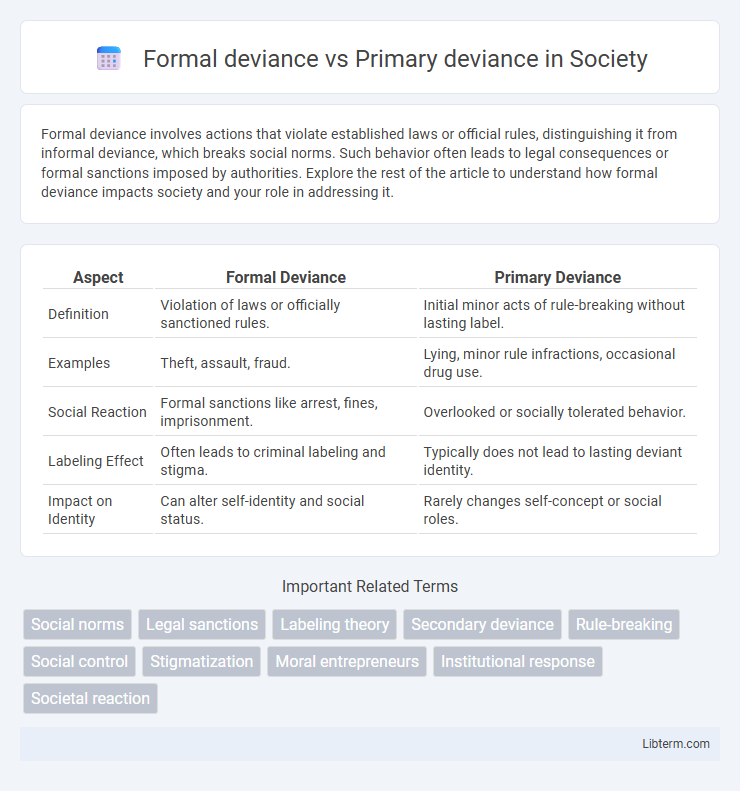Formal deviance involves actions that violate established laws or official rules, distinguishing it from informal deviance, which breaks social norms. Such behavior often leads to legal consequences or formal sanctions imposed by authorities. Explore the rest of the article to understand how formal deviance impacts society and your role in addressing it.
Table of Comparison
| Aspect | Formal Deviance | Primary Deviance |
|---|---|---|
| Definition | Violation of laws or officially sanctioned rules. | Initial minor acts of rule-breaking without lasting label. |
| Examples | Theft, assault, fraud. | Lying, minor rule infractions, occasional drug use. |
| Social Reaction | Formal sanctions like arrest, fines, imprisonment. | Overlooked or socially tolerated behavior. |
| Labeling Effect | Often leads to criminal labeling and stigma. | Typically does not lead to lasting deviant identity. |
| Impact on Identity | Can alter self-identity and social status. | Rarely changes self-concept or social roles. |
Understanding Deviance: An Overview
Formal deviance involves violations of laws or official rules enforced by societal institutions, often resulting in legal sanctions or penalties. Primary deviance refers to minor norm violations that do not result in a person being labeled as deviant and typically go unnoticed or have little social consequence. Understanding these distinctions helps clarify how societal reactions influence the development of deviant identities and social labeling processes.
Defining Formal Deviance
Formal deviance refers to behaviors that violate established laws, rules, or official regulations and are met with formal sanctions such as fines, imprisonment, or other legal penalties. It contrasts with primary deviance, which involves minor norm violations that typically do not result in formal punishment or a label of deviance. Understanding formal deviance is crucial for analyzing how social order is maintained through institutional response and legal enforcement.
What is Primary Deviance?
Primary deviance refers to minor rule-breaking behaviors that do not result in the individual being labeled as deviant by society. These initial acts are often temporary and do not affect a person's self-identity or social status. In contrast, formal deviance involves violations of significant social norms or laws that lead to official sanctions or stigmatization.
Key Differences Between Formal and Primary Deviance
Formal deviance involves violations of laws or official rules that result in legal sanctions or formal punishment, while primary deviance refers to minor norm violations that do not lead to severe social or legal consequences and often go unnoticed by society. The key differences include the presence of formal sanctions in formal deviance versus the informal or no response in primary deviance, as well as the social labeling that typically accompanies formal deviance but is absent or minimal in primary deviance. Formal deviance shapes an individual's social identity through stigma or criminal records, whereas primary deviance often remains a temporary or hidden behavior without lasting impact on the person's social status.
Examples of Formal Deviance in Society
Formal deviance includes actions that violate established laws and official rules, such as theft, fraud, or tax evasion, often resulting in legal penalties or sanctions. Examples of formal deviance in society include criminal offenses like robbery, corporate crimes like embezzlement, and regulatory violations such as illegal drug use. These acts are codified as crimes and prosecuted by governmental institutions, distinguishing them from primary deviance, which involves minor norm violations without severe social consequences.
Instances of Primary Deviance in Everyday Life
Primary deviance refers to minor norm violations that do not result in a person being labeled as deviant, such as occasional lying, minor speeding, or small acts of underage drinking. These everyday instances often go unnoticed or are rationalized, allowing individuals to maintain their social identity without stigma. Unlike formal deviance, which involves serious violations officially sanctioned by institutions, primary deviance remains informal and lacks significant social consequences.
Social Reactions to Formal Deviance
Social reactions to formal deviance typically involve institutionalized responses such as legal sanctions, imprisonment, or fines, reinforcing societal norms through codified laws. These formal controls aim to deter deviant behavior by applying officially recognized punishments managed by criminal justice systems. In contrast, primary deviance elicits informal social reactions like stigma, labeling, or mild disapproval without formal legal consequences, impacting an individual's social identity but not necessarily resulting in official sanctions.
The Role of Social Norms in Primary Deviance
Social norms play a critical role in primary deviance by defining acceptable behaviors and labeling actions as deviant when they violate these expectations. Primary deviance involves minor acts that do not result in the individual being publicly labeled as deviant, allowing the person to avoid forming a deviant identity. These norms establish boundaries that, when crossed, influence whether behavior is privately deviant or escalates to formal deviance.
Impacts of Deviance on Individuals and Communities
Formal deviance, involving violations of laws and regulations, often leads to legal sanctions that can result in stigmatization, social exclusion, and limited opportunities for individuals, impacting their social identity and economic stability. Primary deviance, characterized by minor or initial acts of rule-breaking without significant societal labeling, can influence self-concept and community cohesion subtly, potentially escalating if unchecked. Both forms of deviance affect social norms and community trust, shaping collective responses and reinforcing or challenging social order.
Addressing and Managing Deviant Behavior
Formal deviance involves actions that violate established laws or official norms and typically result in sanctions such as fines or imprisonment, requiring legal or institutional intervention to manage behavior. Primary deviance refers to minor norm violations that do not lead to lasting labels or serious consequences, making social control mechanisms like counseling or informal social responses effective in addressing behavior. Managing deviant behavior requires distinguishing between these types to apply appropriate strategies, such as criminal justice procedures for formal deviance and social support systems for primary deviance.
Formal deviance Infographic

 libterm.com
libterm.com